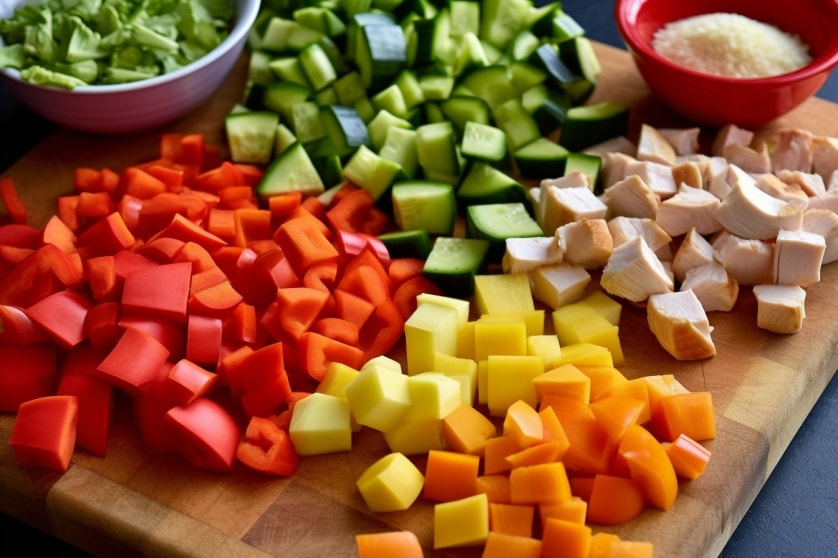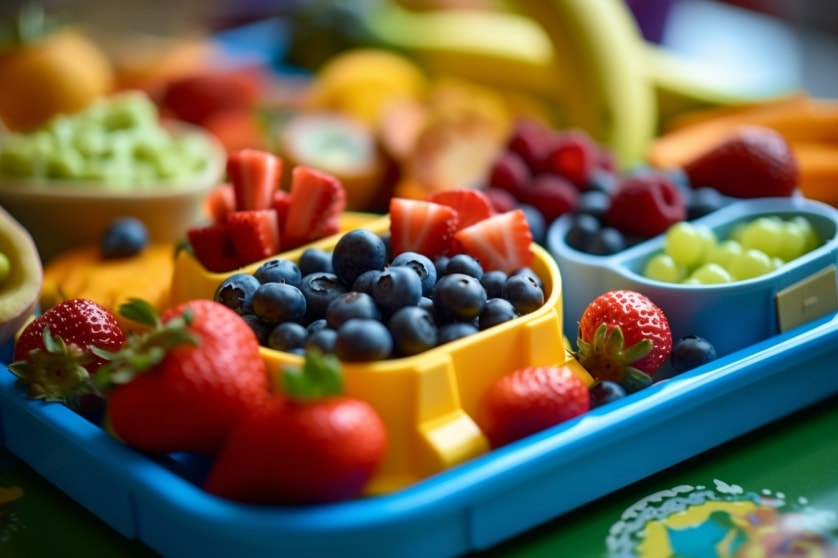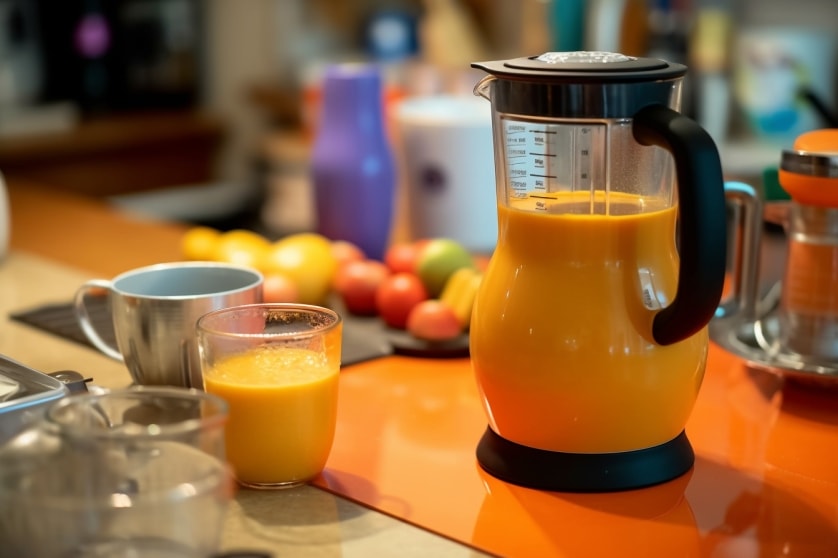Table of Contents
ToggleGuyanese Pepperpot for Babies: A Spicy and Savory Meat Stew with Cassareep
Introduction
Picture this: a cozy kitchen filled with tantalizing aromas, the sound of sizzling spices, and a bubbling pot of Guyanese Pepperpot. It’s a dish that brings together the vibrant flavors of the Caribbean with a touch of warmth and a hint of spice. As a successful woman family care blogger and author with a Caribbean background, I’m here to take you on a culinary adventure that will not only delight your taste buds but also introduce your little one to the wonders of world cuisine.
Now, you might be wondering, what’s so special about Guyanese Pepperpot? Well, let me tell you, it’s more than just a stew. It’s a cultural staple, a symbol of togetherness, and a celebration of flavors that have been passed down through generations. It’s a dish that brings families and communities together, creating memories and forging connections.
But why should we limit these incredible flavors to the adults? Babies, too, deserve a taste of the world and the richness it has to offer. Introducing them to diverse tastes and spices at an early age can shape their palates, expand their culinary horizons, and lay the foundation for a lifelong appreciation of different cuisines.
So, in this article, I’m excited to share with you a modified version of Guyanese Pepperpot that is suitable for babies. We’ll be taking this spicy and savory meat stew and adapting it to ensure a safe and enjoyable culinary experience for your little ones. Together, we’ll embark on a journey that blends tradition with innovation, introducing the wonders of Guyanese cuisine to the youngest members of our families.
Before we dive into the tantalizing details of our baby-friendly Pepperpot recipe, let’s take a moment to appreciate the vibrancy and significance of Guyanese cuisine. The flavors, the techniques, and the stories behind the dishes all contribute to a culinary heritage that is as rich as the flavors themselves.
- But first, let’s set the stage and explore the roots of Guyanese Pepperpot, tracing its origins back to the indigenous people of Guyana and their time-honored cooking techniques.
- We’ll uncover interesting facts about cassareep, the secret ingredient that adds depth and complexity to Pepperpot, and discover its significance in Guyanese cooking.
- Then, we’ll delve into the art of modifying Pepperpot for your little one, offering tips and tricks to ensure a baby-friendly preparation that still captures the essence of the dish.
- Of course, we’ll also discuss the benefits of Guyanese Pepperpot for babies, exploring how this flavorful stew can nourish their growing bodies and adventurous taste buds.
- And finally, we’ll wrap up with a step-by-step guide to preparing our baby-friendly Guyanese Pepperpot, because there’s no better way to bring these vibrant flavors to your little one’s plate than through a homemade creation.
So, get ready to embark on a culinary journey that celebrates the flavors of the Caribbean and nourishes your baby’s taste buds. Together, we’ll unlock the secrets of Guyanese Pepperpot, adapt it for our little ones, and create delicious memories that will last a lifetime. Let’s dive in!

Section 1: The Flavorful Tradition of Guyanese Pepperpot
Exploring the roots
Ah, Guyanese Pepperpot! The very name conjures up images of steaming pots, hearty flavors, and the warmth of family gatherings. But where did this delectable dish originate? Let’s travel back in time and uncover the roots of this flavorful tradition.
Long before supermarkets and modern conveniences, the indigenous people of Guyana relied on their ingenuity to create nourishing meals with the resources available to them. It was during this era that the foundations of Guyanese Pepperpot were laid. The Amerindians, the original inhabitants of Guyana, developed a unique cooking technique that transformed simple ingredients into a dish that would become a beloved cultural symbol.
The secret to the tantalizing flavors of Pepperpot lies in the slow simmering process. Traditionally cooked in a large earthenware pot over an open fire, the stew is allowed to simmer for hours, allowing the flavors to meld together and develop their distinct character. The result? A robust, savory, and aromatic dish that warms both the belly and the soul.
But Guyanese Pepperpot is more than just a meal. It’s a tradition that has been passed down through generations, bringing families together and creating lasting memories. In Guyana, Pepperpot is often associated with special occasions, such as Christmas or New Year’s celebrations. The enticing aroma fills the air, signaling the start of a festive gathering where loved ones come together to share laughter, stories, and, of course, a steaming bowl of Pepperpot.
One fascinating aspect of Guyanese cuisine is its regional diversity. As you travel across the regions of Guyana, you’ll discover that each has its own unique twist on Pepperpot. In the coastal regions, the stew tends to be richer and spicier, often featuring ingredients such as beef, pork, or even wild game. In the interior regions, where the Amerindian influence is strongest, Pepperpot might incorporate ingredients like cassava or plantains, adding a delightful earthy undertone to the dish.
As you can see, Guyanese Pepperpot is more than just a culinary creation; it’s a tapestry of history, culture, and community. It reflects the resourcefulness and creativity of the Guyanese people, who transformed humble ingredients into a dish that has stood the test of time.
Now that we’ve explored the roots of Guyanese Pepperpot and gained an understanding of its cultural significance, it’s time to delve deeper into the ingredients that give this stew its unique flavor profile. Join me in the next section as we uncover the secrets of cassareep, the secret ingredient that adds a tangy and complex twist to Guyanese Pepperpot!

Section 2: Interesting Facts about Cassareep
The secret ingredient
Prepare to have your taste buds tantalized and your curiosity piqued as we uncover the secret behind the unique and enchanting flavors of Guyanese Pepperpot. It’s time to shine the spotlight on the star of the show: cassareep.
Cassareep is a magical elixir that adds depth, complexity, and a tangy twist to Guyanese cuisine. But what exactly is cassareep? Well, my fellow culinary adventurers, cassareep is a special sauce made from the juice of the cassava root. It undergoes a fascinating transformation as it is reduced, thickened, and simmered, resulting in a dark, syrupy concoction that packs a flavor punch like no other.
Now, here’s an interesting tidbit: cassareep owes its dark color to a natural chemical reaction called the Maillard reaction. This reaction occurs when the sugars in the cassava juice combine with amino acids during the cooking process, resulting in the deep brown hue that we associate with cassareep. So, you see, it’s not just a sauce; it’s a work of culinary science!
In Guyanese cooking, cassareep is not limited to Pepperpot. It’s a versatile ingredient that adds a distinctive tang and complexity to various dishes. Think of it as the secret weapon in the culinary arsenal of Guyana. It’s often used to marinate meats, adding a sweet and sour flavor profile that enhances the taste and tenderizes the proteins. Whether you’re grilling chicken, braising beef, or preparing a succulent roast, a splash of cassareep can elevate your dish to new heights of deliciousness.
But cassareep isn’t just about flavor; it also holds a special place in the hearts of the Guyanese people. This dark elixir has deep cultural roots, particularly within the Amerindian communities of Guyana. For them, cassareep is more than just a condiment; it’s a symbol of heritage, tradition, and connection to the land. The process of making cassareep is often a communal affair, bringing families and communities together to celebrate the bounty of the cassava harvest.
Now, you might be wondering, what about the nutritional benefits of cassareep? Well, my friends, cassava, the root from which cassareep is derived, is a powerhouse of nutrients. It’s rich in carbohydrates, providing a sustainable source of energy. Cassava also contains essential minerals like potassium and magnesium, which support proper muscle function and overall well-being.
But that’s not all! Cassareep has another hidden treasure within its dark depths: iron. Yes, you heard it right. Cassareep is a surprising source of iron, a vital mineral that plays a crucial role in the healthy growth and development of our little ones. So, by incorporating cassareep into our modified Guyanese Pepperpot for babies, we’re not only tantalizing their taste buds but also nourishing their bodies.
Now that we’ve unraveled the mysteries of cassareep and its role in Guyanese cuisine, it’s time to move on to the exciting task of modifying Pepperpot for our little ones. Join me in the next section as we discover how to adapt this flavorful stew to ensure a safe and enjoyable culinary experience for our precious bundles of joy!

Section 3: Baby-Friendly Preparation: Spices, Consistency, and Safety
Baby-friendly preparation
Alright, dear parents and caregivers, it’s time to put on our aprons, tie up our culinary capes, and embark on the exciting journey of modifying Guyanese Pepperpot for our little ones. We want to introduce them to the flavors of the world while ensuring their safety and enjoyment. So, let’s dive into the baby-friendly realm of Pepperpot preparation!
First things first: spices. We all know that Pepperpot packs a punch when it comes to flavor, thanks to its array of aromatic spices. But when it comes to our little ones, we need to take a gentle approach. We want to introduce them to the essence of Pepperpot without overwhelming their developing palates. So, here’s the secret: go easy on the heat. You can reduce the amount of hot peppers or eliminate them altogether, ensuring a milder flavor profile that still captures the essence of this beloved dish.
Now, let’s talk about consistency. Our little explorers are still discovering the world of solid foods, so we want to ensure a texture that is safe and manageable. The traditional Pepperpot tends to have a thick stew-like consistency, which may be challenging for our little ones to handle. Fear not, for we have a solution! Consider adjusting the consistency by blending or pureeing the stew to a smoother texture. This not only makes it easier for babies to eat but also allows them to experience the rich flavors in a way that is gentle on their developing digestive systems.
But wait, there’s more! We can also customize the ingredients to suit our little ones’ needs. Instead of using tougher cuts of meat, opt for tender cuts that are easier to chew and digest. You can also incorporate nutrient-rich vegetables into the stew, such as carrots, sweet potatoes, or peas, to boost the nutritional value and add some vibrant colors to the dish.
When preparing Pepperpot for babies, it’s essential to prioritize safety. Here are a few key tips to keep in mind:
- Ensure that all ingredients are fresh and of high quality. Fresh ingredients not only enhance the flavors but also provide optimal nutrition for our little ones.
- Thoroughly cook the meat to ensure it is tender and easily chewable for our babies. This also helps eliminate any potential bacteria or pathogens that might be present.
- Allow the stew to cool to an appropriate temperature before serving it to your baby. We want to avoid any risk of burns or discomfort.
- Always supervise your little one during mealtime, ensuring they are seated upright and safely secured in their high chair. This helps prevent choking hazards and allows for a more enjoyable dining experience.
By following these tips, we can create a modified Pepperpot that is not only bursting with flavor but also safe and suitable for our little gastronomes.
Now that we’ve mastered the art of preparing a baby-friendly Pepperpot, it’s time to uncover the incredible benefits that this flavorful stew holds for our little ones. Join me in the next section as we explore the nourishing qualities and adventurous advantages of Guyanese Pepperpot for babies!

Section 4: Nurturing Little Taste Buds: Benefits of Guyanese Pepperpot for Babies
Nurturing little taste buds
Ah, the wonders of Guyanese Pepperpot! This tantalizing stew not only delights our own taste buds but also holds a multitude of benefits for our little ones. As we introduce them to the world of flavors and textures, let’s dive into the nourishing qualities and adventurous advantages that Pepperpot brings to the table.
First and foremost, Guyanese Pepperpot is a treasure trove of flavors. By exposing our babies to a variety of tastes, we expand their palate and cultivate their adventurous spirit. The aromatic blend of spices and the richness of the stew introduce them to a whole new world of sensory experiences. From the earthy undertones of cassava to the savory notes of tender meat, each spoonful of Pepperpot offers a symphony of flavors that awaken their taste buds and spark their curiosity.
But it’s not just about the flavors; Pepperpot is a nutritional powerhouse as well. This hearty stew is packed with essential nutrients that support our babies’ growth and development. The combination of protein from the meat, vitamins from the vegetables, and the natural goodness of cassava creates a well-rounded meal that nourishes their little bodies.
One of the standout ingredients in Pepperpot is cassava, which not only adds flavor but also provides a range of health benefits. Cassava is a great source of dietary fiber, aiding in digestion and promoting a healthy gut. It also contains vitamin C, an important nutrient that supports the immune system and helps our little ones stay strong and healthy.
Another benefit of Pepperpot is its versatility. As we modify the stew to suit our babies’ needs, we can incorporate a variety of ingredients that offer additional nutritional benefits. From vibrant carrots loaded with beta-carotene to sweet potatoes packed with vitamins and minerals, each ingredient adds its own unique contribution to the nutritional value of the dish.
Introducing our babies to the flavors of Guyanese Pepperpot also fosters a sense of cultural appreciation. Food is an essential part of our cultural heritage, and by sharing dishes like Pepperpot with our little ones, we pass on traditions, stories, and a connection to our roots. It’s a beautiful way to celebrate our heritage and create lasting memories with our families.
Now, we understand that every baby is unique, and some little taste buds may be more sensitive than others. If you notice any signs of discomfort or allergies when introducing Pepperpot, it’s important to consult with your pediatrician. They can provide guidance and support to ensure a safe and enjoyable culinary journey for your little one.
So, my fellow culinary adventurers, let’s embrace the flavors, the nutrition, and the cultural richness that Guyanese Pepperpot brings to our babies’ world. Let’s nurture their little taste buds and watch as they embark on a lifelong love affair with diverse and delicious cuisines.
With our modified Pepperpot recipe in hand, it’s time to head to the kitchen and embark on a flavor-filled adventure. Join me in the next section as we uncover the simple ingredients and steps to create a baby-friendly version of this beloved Guyanese stew!

Section 5: Introduce the Modified Recipe: A Baby-Friendly Twist on Guyanese Pepperpot
Introduce the modified recipe
Get ready to embark on a culinary adventure that will delight both you and your little one! It’s time to introduce the modified recipe for a baby-friendly version of Guyanese Pepperpot. Brace yourselves for a mouthwatering experience that captures the essence of this beloved stew while keeping our babies’ taste buds and tummies happy.
Here are the simple ingredients and steps to create your very own baby-friendly Pepperpot:
Ingredients:
- 1 pound of tender meat (such as beef or chicken), diced into small pieces
- 2 cups of low-sodium beef or chicken broth
- 1 cup of cassava juice (cassareep)
- 1 onion, finely chopped
- 2 cloves of garlic, minced
- 1 carrot, peeled and diced
- 1 sweet potato, peeled and diced
- 1 bay leaf
- 1 teaspoon of thyme leaves
- 1 tablespoon of olive oil
- Salt and pepper to taste
Instructions:
- In a large pot, heat the olive oil over medium heat. Add the onions and garlic, and sauté until they turn golden and fragrant.
- Add the diced meat to the pot and cook until it browns on all sides.
- Pour in the beef or chicken broth, cassava juice (cassareep), and add the bay leaf and thyme leaves. Stir well to combine.
- Reduce the heat to low, cover the pot, and let the stew simmer for about 1 hour or until the meat becomes tender and the flavors meld together.
- Add the diced carrots and sweet potatoes to the pot and continue simmering for an additional 15-20 minutes or until the vegetables are cooked through.
- Season with salt and pepper to taste, and give it a final stir.
- Remove the bay leaf before serving.
Voila! Your baby-friendly Guyanese Pepperpot is ready to be savored by your little one.
But wait, there’s more! Remember, we’re creating a modified version of Pepperpot specifically tailored to our babies’ needs. So, before serving, let’s make sure the consistency is suitable for our little gastronomes. If desired, you can blend or puree the stew to a smoother texture, making it easier for your baby to enjoy.
Now, it’s time to gather the family around the table and savor this delectable dish together. Watch as your little one’s eyes light up with delight as they experience the flavors, textures, and love that went into preparing this special meal.
But don’t limit yourself to just one serving! This baby-friendly Pepperpot is a dish that the whole family can enjoy. So, go ahead and savor the rich flavors and cultural heritage that Guyanese cuisine has to offer.
Remember, cooking is an art, and recipes are merely a starting point. Feel free to add your own creative twists and variations to this modified Pepperpot. Let your taste buds guide you as you explore the endless possibilities.
So, my fellow culinary adventurers, it’s time to bring the flavors of Guyana into your kitchen and create a memorable dining experience for your little one. Enjoy the journey, embrace the flavors, and let your baby’s taste buds dance with joy!
And there you have it! A baby-friendly twist on the classic Guyanese Pepperpot that will leave your little one asking for more. Join me in the final section as we wrap up our culinary exploration and reflect on the joys of introducing diverse and delicious cuisines to our precious little eaters.
Conclusion: A Flavorful Journey for Your Little One
Congratulations, fellow foodie parents! You’ve embarked on a flavor-filled journey with your little one, introducing them to the wonders of Guyanese Pepperpot. We’ve explored the roots of this beloved stew, uncovered the secret ingredient that gives it its unique flavor, shared tips for baby-friendly preparation, and celebrated the benefits of nurturing our little ones’ taste buds.
By incorporating diverse and delicious cuisines into our babies’ meals, we not only expand their palate but also cultivate a lifelong love for food and a sense of cultural appreciation. Guyanese Pepperpot, with its rich history and tantalizing flavors, offers a gateway to explore the world of culinary delights.
Through this adventure, we’ve learned that Pepperpot is more than just a stew. It’s a cultural experience that connects us to our heritage, creates lasting memories with our families, and ignites a passion for exploring flavors and cuisines from around the globe.
As you prepare and modify Pepperpot for your little one, remember to let your creativity shine. Feel free to experiment with different ingredients, spices, and textures to tailor the recipe to your baby’s needs and preferences. Cooking is an art, and with each delicious creation, you’re nurturing both their bodies and their spirits.
So, whether you have a little foodie in the making or a discerning eater who needs a gentle nudge, Guyanese Pepperpot is here to spark their taste buds and ignite their culinary curiosity. Embrace the adventure, celebrate the flavors, and enjoy the precious moments shared around the family table.
As we conclude this flavor-filled journey, remember that introducing your little one to new tastes and textures is just the beginning. It’s a stepping stone towards a lifetime of exploration and appreciation for the diverse world of food. So, keep on discovering, keep on cooking, and most importantly, keep on savoring the joy that comes with nourishing and delighting your little one.
Thank you for joining me on this culinary adventure. Until our next delicious escapade, happy cooking, fellow foodie parents!
Want to take your knowledge to the next level? Check out these must-read articles:
- Dominican Morir Soñando for Babies: A Creamy and Refreshing Drink with Orange Juice and Milk
- Bahamian Conch Salad for Babies: A Fresh and Citrusy Seafood Salad
Organize your baby’s wardrobe with our baby clothes closet organizer products! Our organizers are designed specifically for baby clothes. Get your baby’s clothes neat and tidy with our selection of organizers – shop now!
- Picky Eating Prevention: Foundations in the First Year - October 17, 2025
- The Great Nursing Strike: Causes and Solutions - October 7, 2025
- DIY Baby Food: Equipment-Free Approaches - October 1, 2025



